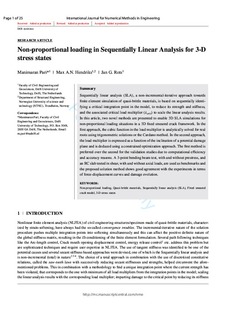| dc.contributor.author | Pari, Manimaran | |
| dc.contributor.author | Hendriks, Max | |
| dc.contributor.author | Rots, Jan G | |
| dc.date.accessioned | 2020-03-16T11:09:11Z | |
| dc.date.available | 2020-03-16T11:09:11Z | |
| dc.date.created | 2019-08-13T15:07:51Z | |
| dc.date.issued | 2019 | |
| dc.identifier.citation | International Journal for Numerical Methods in Engineering. 2019, 119 (6), 506-531. | nb_NO |
| dc.identifier.issn | 0029-5981 | |
| dc.identifier.uri | http://hdl.handle.net/11250/2646927 | |
| dc.description.abstract | Sequentially linear analysis (SLA), a non‐incremental‐iterative approach towards finite element simulation of quasi‐brittle materials, is based on sequentially identifying a critical integration point in the model, to reduce its strength and stiffness, and the associated critical load multiplier (λcrit), to scale the linear analysis results. In this article, two novel methods are presented to enable SLA simulations for non‐proportional loading situations in a three‐dimensional fixed smeared crack framework. In the first approach, the cubic function in the load multiplier is analytically solved for real roots using trigonometric solutions or the Cardano method. In the second approach, the load multiplier is expressed as a function of the inclination of a potential damage plane and is deduced using a constrained optimization approach. The first method is preferred over the second for the validation studies due to computational efficiency and accuracy reasons. A three‐point bending beam test, with and without prestress, and an RC slab tested in shear, with and without axial loads, are used as benchmarks. The proposed solution method shows good agreement with the experiments in terms of force‐displacement curves and damage evolution. | nb_NO |
| dc.language.iso | eng | nb_NO |
| dc.publisher | Wiley | nb_NO |
| dc.title | Non-proportional loading in sequentially linear analysis for 3D stress states | nb_NO |
| dc.type | Journal article | nb_NO |
| dc.type | Peer reviewed | nb_NO |
| dc.description.version | acceptedVersion | nb_NO |
| dc.source.pagenumber | 506-531 | nb_NO |
| dc.source.volume | 119 | nb_NO |
| dc.source.journal | International Journal for Numerical Methods in Engineering | nb_NO |
| dc.source.issue | 6 | nb_NO |
| dc.identifier.doi | 10.1002/nme.6060 | |
| dc.identifier.cristin | 1715649 | |
| dc.description.localcode | This is the peer reviewed version of an article, which has been published in final form at [https://doi.org/10.1002/nme.6060]. This article may be used for non-commercial purposes in accordance with Wiley Terms and Conditions for Self-Archiving. | nb_NO |
| cristin.unitcode | 194,64,45,0 | |
| cristin.unitname | Institutt for konstruksjonsteknikk | |
| cristin.ispublished | true | |
| cristin.fulltext | postprint | |
| cristin.qualitycode | 2 | |
